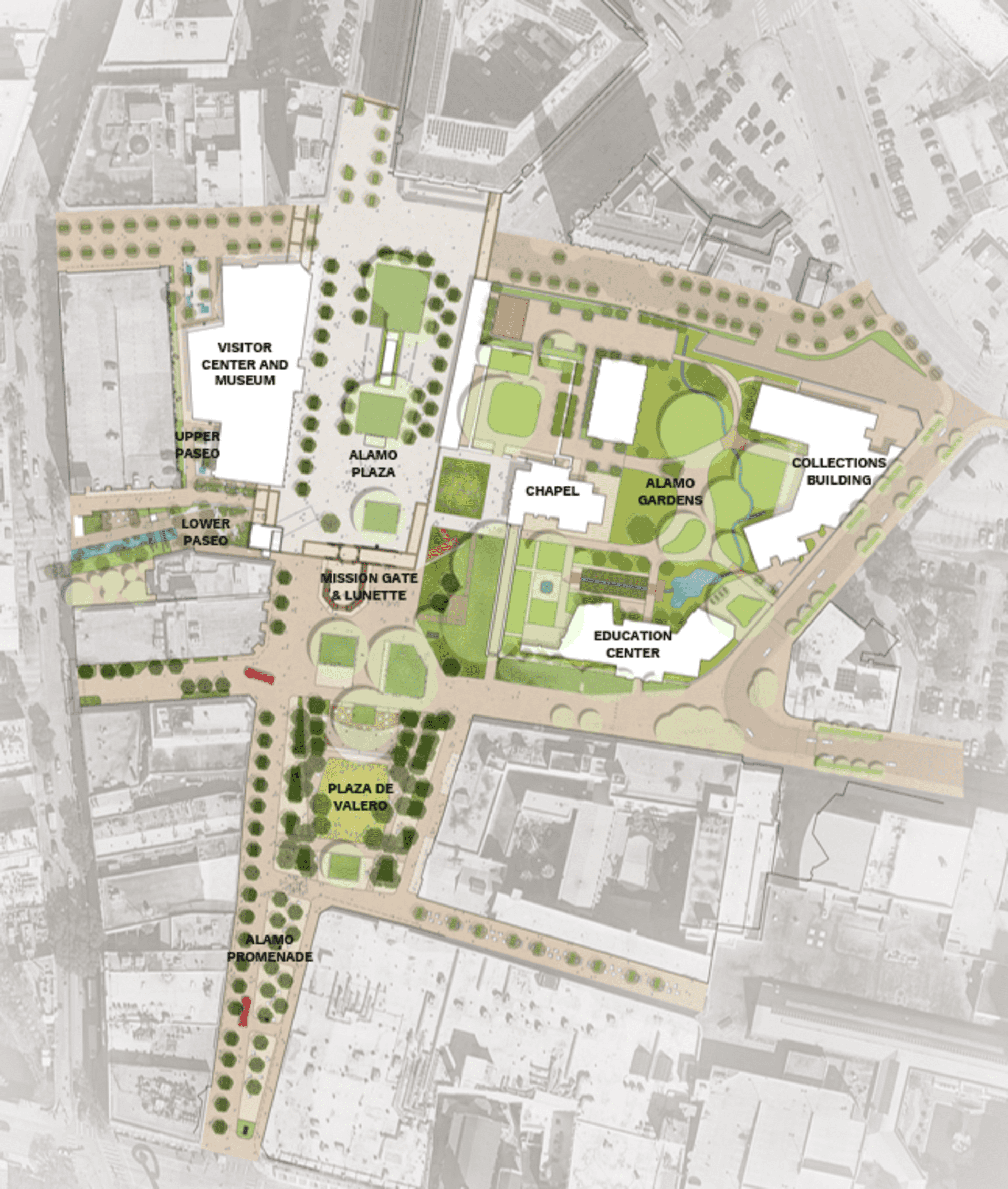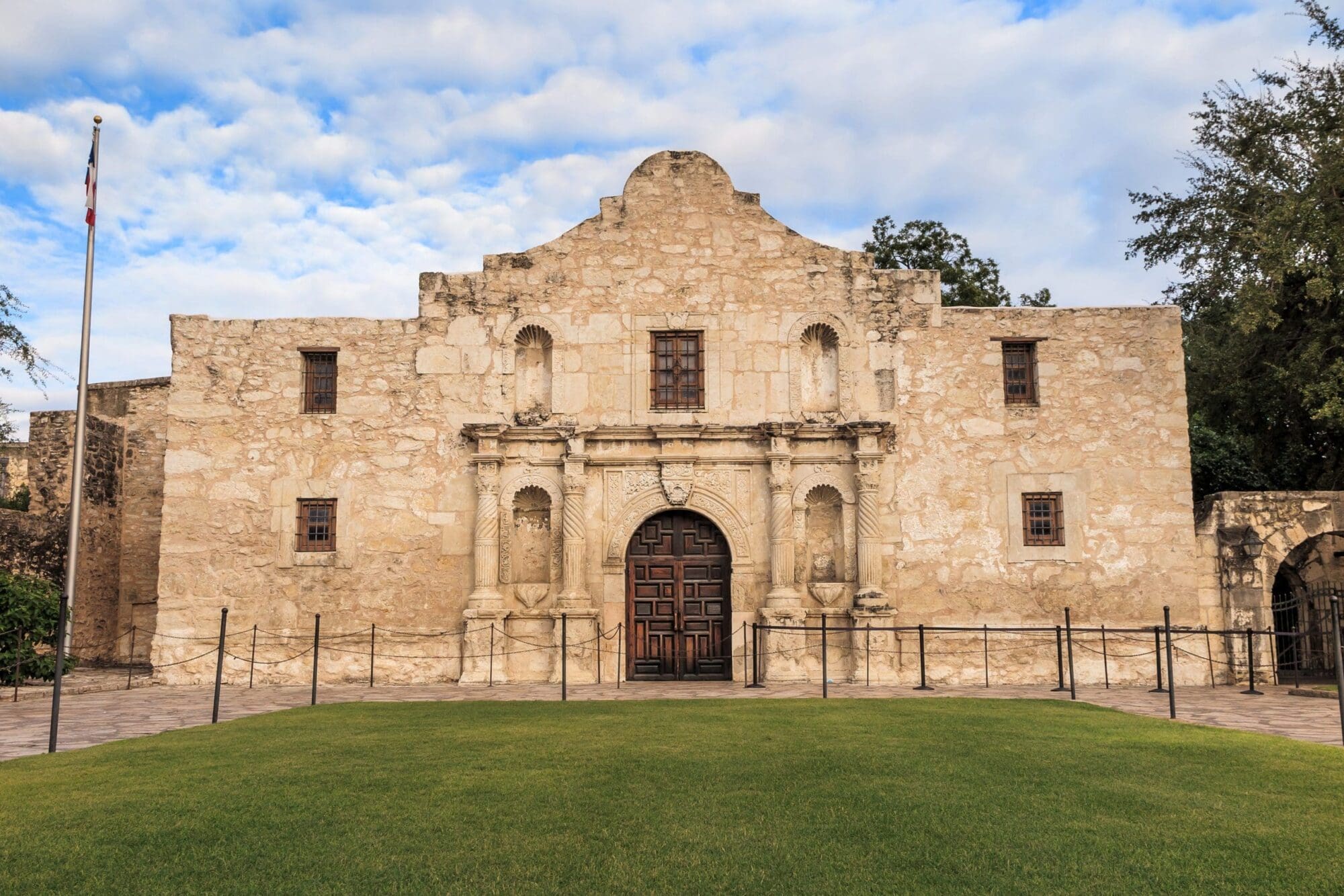Over the last decade, the Alamo has undergone vast redevelopment backed by over $550 million in investments.
“As Land Commissioner, I am charged with protecting and preserving our Shrine of Texas Liberty: the Alamo. I am proud to share, for the first time ever, we are ensuring a visit to the Alamo is worthy of the significance of the events that happened there,” Commissioner Dawn Buckingham told Texas Scorecard.
The Alamo Plan focuses on the comprehensive restoration of Alamo Church, the Long Barrack, and Alamo Cenotaph, while dramatically transforming Alamo Plaza and its surrounding properties into a premier historic site.
Church and Long Barrack
The 300-year-old church and Long Barrack are the last remaining original structures of the Alamo. Over the years, however, the church and Long Barrack’s stone walls have been chipping off, leaving much of the interior structure exposed to damage.
“The limestone has been wicking the moisture from the ground for a very long time. If you’ve ever seen limestone around a salt water pool and you’ve seen how it melts, when you look inside of the walls[,] it is melted,” Buckingham commented.
In 2024, the Alamo’s restoration efforts revealed that the church’s 104-year-old roof had severe water damage and required replacement.
Efforts to replace the church’s roof and restore its walls require a temporary enclosure, slated for construction next year, to protect the church from the elements during roofing work.
Cenotaph
Similarly to the church, the Alamo Cenotaph’s inner structure weakened over time due to water damage, among other factors.
Restoration began in early 2025, and repairs—concrete reinforcement, waterproofing, and internal stone restoration—will be completed by autumn. The monument’s original location will be kept.
Alamo Plaza
Initially, the Alamo Plan only focused on Alamo Plaza. Today’s iteration recaptures the Alamo’s original footprint, which lies beneath Alamo Plaza.
This will delineate most of the Alamo’s original location, allowing visitors to see exactly where the former mission and its defenders once stood and correcting the long-standing misconception that the Alamo only consists of the church and Long Barrack.
Efforts to accomplish this have included closing several roads surrounding the Alamo and converting them into pedestrian-only zones to accommodate more visitors.
Plaza de Valero is being redeveloped with new seating, green space, and a performance pavilion, while the Alamo Promenade—gateway to the Alamo—is being furnished with new statues to commemorate those who died defending the former mission.
Visitor Center
The central redevelopment aspect of the Alamo Plan is the forthcoming Alamo Visitor Center and Museum. Dubbed the “Crown Jewel of the Alamo Plan,” construction began in October of last year and is expected to conclude in 2027, marking the plan’s final phase.
The nearly 100,000-square-foot building will feature a 4D theatre, an events space, and eight galleries. The galleries will include exhibits about the 1836 Battle of the Alamo, its aftermath, the several-thousand-year history of the area, and the subsequent growth of San Antonio around the Alamo.
Education
Opened in March 2023, the Ralston Family Collections Center is a two-story gallery space used to display artifacts from the Phil Collins Collection and others collected throughout the years.
In addition, the Texas Cavaliers Education Center broke ground in November 2023 and serves as a learning center for various fields, including STEM.
The education center had its topping out ceremony in May and is expected to be completed in March of next year. It also features an outdoor classroom within the Alamo Complex and a theater that brings the Alamo’s history to life.
Projections anticipate 2.5 million visitors annually upon completion of the Alamo Plan in 2027.

Courtesy of the Alamo Trust, Inc.
History
The Alamo Plan’s framework, drawn from a 1994 city report and formalized by the 2014 Alamo Plaza Advisory Committee, evolved alongside public demands for historical accuracy.
In 2015, the City of San Antonio partnered with the General Land Office (GLO)—under the leadership of former Land Commissioner George P. Bush—and the Alamo Endowment to “reimagine” the Alamo with the Alamo Plan, formally marking its establishment.
For three years, the Alamo Master Plan Management Committee formed from this partnership developed the Alamo Plan.
At the end of the planning process in 2018, the GLO leased Alamo Plaza from the City of San Antonio and began working with the Alamo Trust to facilitate the Alamo Plan’s changes, conduct restoration efforts, and lead the processes designated in the plan.
The lease, which remains in effect, provides the GLO control over Alamo Plaza for 50 years, with two 25-year extensions possible with approval by the San Antonio City Council.
Previously, the Alamo Plaza lease stipulated that the GLO recognize the City of San Antonio’s ownership of the Cenotaph and promise to help facilitate its relocation in congruence with the Alamo Plan.
However, an extension in May 2024 transferred ownership of the Cenotaph to the GLO and extended the lease to include the Plaza de Valero.
The final say for the Alamo Plan lies with the Mayor of San Antonio—currently Gina Ortiz Jones—and the GLO Land Commissioner—currently Dawn Buckingham.
This shared leadership design ensures that the direction remains in accord with the agreed-upon Vision and Guiding Principles, which include a commitment to telling the story of the 1836 Battle of the Alamo and restoring the area to its former reverence, free from 21st-century distractions.
Controversy
A shared notion among many in the planning process is a commitment to make Alamo Plaza “period-neutral.” This would ensure that the Alamo tells the story of the entire area and the diverse groups of people that lived there.
Regarding the people who fought at the Alamo, Buckingham has said:
I’m unapologetically for our Texas history. I want to be very clear [on] our Alamo defenders. We had Texans, we had Tejanos, we had African Americans, [and] we had women. It was a diverse group of people held together by a liberty of mind and a dislike of tyrants.
However, some have raised concerns that a vague understanding of what it means to be “period neutral” could facilitate efforts from historical revisionists to scrub and rewrite the real history of Texas’ independence.
In various committee and city meetings, advocates have called for the Alamo Plan to place less emphasis on the “Anglo-centric” history of the area and instead tell the story of the Alamo in a “less romanticized” way.
Such talking points have sparked debate about attempted historical revisionism depicting Texas’ independence as “Anglo-dominism of a struggling new country.”
These revisionist claims culminated in a years-long fight to protect the Alamo Cenotaph, which critics called a “white establishment icon.”
The Alamo Citizen Advisory Committee—one of the oversight committees responsible for overseeing the Alamo Plan—actively worked to push forward the proposal to relocate the Cenotaph from its current location in Alamo Plaza.
Lt. Gov. Dan Patrick responded by accusing members of this committee of trying to erase Texas’ history.
Patrick also criticized both former Land Commissioner George P. Bush for allowing the attempt in the first place and the Alamo Plan for lack of transparency on the matter.
Resolutions
The Legislature allotted nearly $400 million for the Alamo Plan in 2023.
Over the last three years, the GLO and Alamo Trust have sought to address the controversial aspects of the Alamo Plan, particularly after Buckingham’s election in November 2022.
Buckingham was responsible for striking the deal to transfer the Cenotaph to the GLO.
A passionate advocate for defending history, she has set up a live cam to provide oversight during the Cenotaph’s restoration process.
“The Alamo is a sacred place where history, sacrifice, and pride come together to tell the powerful story of Texas independence. Our state’s rich history binds all Texans, and now every child will be able to learn about our loud and proud, liberty or death, line-in-the-sand Texas history,” Buckingham told Texas Scorecard.
No ads. No paywalls. No government grants. No corporate masters.
Just real news for real Texans.
Support Texas Scorecard to keep it that way!

